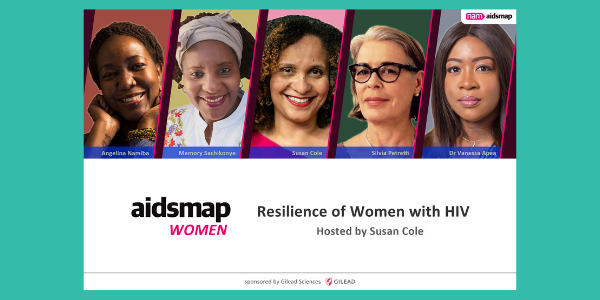News from aidsmap

Ten-year Italian study shows that people with HIV remain undetectable for 97% of the time
Long-term monitoring of people with HIV with an undetectable viral load has shown that viral suppression is rarely lost, enforcing the validity of 'U=U' (Undetectable equals Untransmittable) messaging, according to Italian research published in the online edition of AIDS. The study involved over 8000 HIV-positive individuals taking antiretroviral therapy (ART) and with viral suppression (a viral load below 200) at baseline.
Self-testing trebles HIV testing rate among trans people in UK study
Trans people are more likely to test for HIV, and test more often, when provided with self-tests, according to research from England and Wales published in EClinicalMedicine. Ninety-five per cent of trans participants who received a self-test tested for HIV compared to 26% of those who did not, while those who were offered repeat tests reported three times the rate of HIV testing compared to those who received a one-off test.
Not all PrEP programmes are screening for STIs
There are significant gaps in the provision of STI testing services in PrEP programmes, according to research published in the Journal of the International AIDS Society. Analysis of 91 separate programmes showed that 30% were not routinely testing for STIs either before treatment was started or at regular intervals thereafter. Screening rates were higher in wealthier settings than in low- and middle-income countries. Barriers to integrating STI testing included staff capacity and funding.

Elderly women more likely than men to have inappropriately prescribed medicines
A recent Swiss study found a high prevalence of polypharmacy (66%) and inappropriate prescribing (67%) among people living with HIV aged 75 and older. Forty per cent of these prescribing issues posed a risk for harmful consequences. Inappropriate prescribing was more frequent in women than in men, which can be partially explained by sex differences in non-HIV co-morbidities.
Low CD4 cell count linked to increased risk of cancer among people with HIV in South Africa
Immune suppression is associated with an increased risk of numerous infection-related cancers among people with HIV in South Africa, investigators report in Clinical Infectious Diseases. There was a strong association between a lower CD4 cell count and the incidence of Kaposi's sarcoma, non-Hodgkin lymphoma, cervical cancer and other cancers linked to human papillomavirus (HPV), as well as conjunctival cancer (a malignancy of the eye).
Higher smoking prevalence among people with HIV in almost all world regions
People living with HIV are approximately two-thirds more likely to be current tobacco smokers than HIV-negative individuals, according to the findings of a global meta-analysis published in AIDS. Elevated smoking prevalence was observed in both men and women with HIV and in all world regions except the Western Pacific.

Top 5 stories on injectable HIV treatment and prevention from CROI 2021
One of the most important HIV conferences of the year, the Conference on Retroviruses and Opportunistic Infections (CROI 2021), took place earlier this month. A key theme was the development of injectable medications for use as HIV treatment or as pre-exposure prophylaxis (PrEP).
Top 5 stories on HIV, ageing and co-morbidities from CROI 2021
CROI 2021 presented the latest research on ageing and additional health concerns for people living with HIV. Here are the highlights.
Top 5 stories on HIV treatment and care in Africa from CROI 2021
An enormous quantity of important and fascinating HIV research is presented each year at CROI. As it is hard for anyone to keep up, here is a round-up of the news relevant to the HIV treatment programmes in sub-Saharan Africa.

Doubling the dose of emergency contraception is a safe and effective way of overcoming efavirenz interaction
Doubling the dose of the emergency contraception drug levonorgestrel can overcome an interaction between the medication and efavirenz, according to research presented to CROI 2021. The 3.0mg levonorgestrel dose achieved increases in blood concentrations of the drug of between 51 and 133% compared to the standard 1.5mg dose, therefore compensating for efavirenz-associated interactions. Doubling the dose was safe with no reported side effects.
Near point-of-care viral-load tests slash waiting times in seven African countries
Near point-of-care (POC) viral-load testing reduced the median time of getting results back to people living with HIV from 68 days to six days, when compared to conventional centralised laboratory viral-load testing in seven African countries. ‘Near’ POC devices are placed within health facility laboratories throughout the country, as opposed to within clinics themselves.
Binge drinking more likely to cause death or liver problems in people with HIV
A recent Swiss study looked at mortality (death) and liver disease among people living with HIV by their drinking habits. Compared to all other drinking patterns, people living with HIV who reported binge drinking were more likely to die and more likely to experience liver problems. There was no difference in these outcomes for people with HIV who had non-hazardous drinking, or hazardous drinking without binge drinking.

US study suggests women living with HIV should be screened earlier for non-AIDS co-morbidities
Women living with HIV are at greater risk of developing non-AIDS co-morbidities than their HIV-negative peers, with the difference most evident among younger women, according to US research published in Clinical Infectious Diseases. Overall, women living with HIV were 36% more likely to develop non-AIDS co-morbidities during the study period compared to women without HIV, after adjusting for demographics factors, drug and alcohol use, body mass index (BMI) and income level. This rose to 48% among women aged below 25 – a group not traditionally prioritised in co-morbidity screening guidelines.
Better access to PrEP in the UK, especially through NHS services
A community survey of people interested in PrEP in the UK, run in October and November 2020, shows an increase in access to PrEP compared to previous surveys, alongside numerous other changes that may reflect the impact of the coronavirus pandemic. Respondents reported more event-based dosing, fewer sexual partners and less sexual satisfaction.
Younger age, problems obtaining PrEP, and worries about side effects among the factors associated with PrEP discontinuation in Germany
Factors associated with discontinuing HIV pre-exposure prophylaxis (PrEP) in Germany include younger age, dissatisfaction with sex life, problems obtaining treatment and concerns about side effects, German investigators report in BMC Public Health. The research involved both current and former PrEP users, also showing that 19% of former users reported very inconsistent condom use after discontinuing the treatment, indicating they had a high ongoing risk of contracting HIV.

Study of Spanish youth transitioning to adult care shows positive outcomes, but some face challenges
A study of young people living with HIV in Spain found that after transitioning to adult clinics, virological suppression and CD4 count improved in the following three years. The study suggests that patients at a higher risk of negative outcomes could be earlier identified. A history of childhood virological failure, being transferred before enrolling onto treatment and having a low CD4 count were the main determinants of a detectable viral load, lower CD4 count post-transition, mortality or loss to follow-up.
South Africans continued to receive ART during COVID-19 lockdown, but HIV testing and starting ART were impeded
The worst predictions of modelling studies concerning the impact of the 2020 COVID-19 lockdown on HIV care appear not to have come true in South Africa. A study in The Lancet HIV shows that in the province of KwaZulu-Natal, antiretroviral therapy (ART) provision was maintained throughout. However, the lockdown negatively impacted HIV testing and the number of people starting ART.
News from CROI 2021

Earlier this month, we reported from the annual Conference on Retroviruses and Opportunistic Infections (CROI).
We published almost 30 news articles from the conference, and sent out four news summary bulletins in English, French, Spanish, Portuguese, Russian and Italian.
All our CROI news stories and bulletins are available to read on our conference pages.
Podcast series: Tell Me About It

The final episode of our podcast series 'Tell Me About It' is out now.
In this episode, Dr Naomi Sutton from Channel 4's The Sex Clinic talks to psychosexual therapist and podcaster Kate Moyle. They discuss the roots of stigma, from colonialism to the language of STIs and 'clean' vs 'dirty', and how different things can be now with HIV treatment, PrEP and knowledge.
Editors' picks from other sources
Antiretrovirals for HIV don’t raise birth defect risk | POZ
The risk for birth defects among infants born to HIV-positive women using antiretroviral therapy is the same as those born to women in the US general population, according to a 30-year review presented at the Conference on Retroviruses and Opportunistic Infections (CROI) 2021.
No ‘4th 90’ – Why living well is not a goal when it comes to HIV | Politico
An effort to make quality of life an official UN target may have failed, but it made an impact nonetheless.
WHO publishes new clinical recommendations on HIV prevention, infant diagnosis, antiretroviral therapy initiation and monitoring | World Health Organization
These guidelines provide new and updated recommendations on the use of point-of-care testing in children under 18 months of age and point-of-care tests to monitor treatment in people living with HIV; the treatment monitoring algorithm; and timing of antiretroviral therapy among people living with HIV who are being treated for tuberculosis.
Trials, tinsel & tango: Get to know Linda-Gail Bekker's COVID world | Bhekisisa
Professor Linda-Gail Bekker is the director of the Desmond Tutu HIV Centre and an internationally acclaimed HIV and TB researcher. But right now, she’s in the spotlight as the co-lead investigator of South Africa’s Sisonke COVID vaccine trial.
Gilead and Merck announce agreement to jointly develop and commercialise long-acting, investigational treatment combinations of lenacapavir and islatravir in HIV | Gilead press release
The agreement brings together potentially complementary medicines in late-stage development with the goal to provide innovative, long-acting treatments in HIV.
aidsmapWOMEN

aidsmapWOMEN is now available to watch online. In the third episode of our three-part series, NAM's Susan Cole talks to her guests about the resilience of women living with HIV.
Susan's guests are Angelina Namiba from the 4M Network of Mentor Mothers living with HIV; Memory Sachikonye from UK-CAB; Silvia Petretti, CEO of Positively UK; and Dr Vanessa Apea, an HIV and sexual health consultant at Barts Hospital in London.
